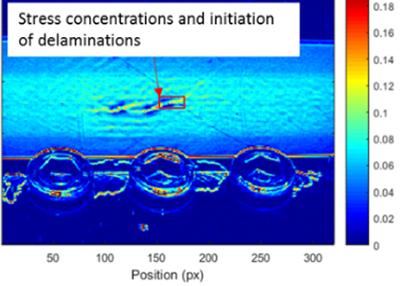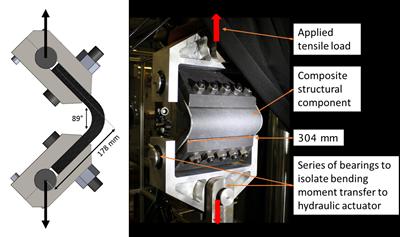D. J. Bull1, R. Butler2, A. T. Rhead2, T. A. Fletcher2, K. D. Potter3, J. M. Dulieu-Barton1 and O. T. Thomsen1
1 Faculty of Engineering and the Environment, University of Southampton, University Road, SO17 1AE, UK
2 Department of Mechanical Engineering, University of Bath, Claverton Down, Bath, BA2 7AY, UK
3 ACCIS (Advanced Composites Centre for Innovation and Science), University of Bristol, Queen’s Building, University Walk, Bristol, BS8 1TR, UK

Background
A key issue in the certification of composite structures within aerospace and other industries is the heavy reliance on coupon level tests that do not always translate well to the sub-structure component and full-scale levels within a ‘building block’ or ‘testing pyramid’ framework. This has a strong bearing on the certification process; many of the design allowables and failure predictions are determined from the behaviour of coupon specimens. However, when a component is produced, the material response changes under more complex loading configurations and the features incorporated to achieve the desired component geometry.
The overarching goal of this work is to demonstrate the utilisation of data-rich non-destructive testing (NDT) methods as a facilitator for the adaptation of ‘high fidelity’ testing methodology that can be applied to structural composite sub-structures and components and reduce the reliance on coupon level testing. In particular, there is a need for full-field inspection techniques that are fast and reliable. Through improved understanding of components and structures, a long-term goal of this work is to contribute towards the adaptation of a ‘high fidelity’ testing methodology enabling redefinition of design allowables on the sub-structure and component levels and to minimise costly scrappage during component manufacture.
Role of Computed Tomography
The project made use of the Hutch X-ray computed tomography (CT) facilities at μ-VIS X-ray Imaging Centre. CT scans were successfully undertaken on a large “L” shaped composite component containing an internal manufacturing defect (ply waviness). The component had a limb length of 178 mm, a span of 304 mm and a thickness ~21 mm. Scans were taken before and after failure of the component to capture the geometry of the subsurface wrinkle defect and damage which had initiated and propagated from this defect after loading. The geometry of subsurface ply waviness was quantified from CT data and used as inputs for finite element models to establish the knockdown to strength on the component prior to experimental mechanical loading.
Both CT and modelling data were used to complement surface-based inspection techniques consisting of lock-in digital image correlation (LIDIC) and thermoelastic stress analysis (TSA). These surface-based techniques were used to simultaneously inspect the component with an applied cyclic load to excite the stress and strain response. LIDIC is an extension of traditional digital image correlation (DIC) where white light cameras track the deformation of an applied speckle pattern to generate a full-field strain map from a loaded structure. Due to the limited frame-rate of white cameras used for DIC (<2 Hz) and the typical cyclic loading rates (5-10 Hz), the lock-in process enables undersampling of a cyclically loaded component to determine the peak-to-peak strains without the need to be synchronised with the maximum and minimum loads of the cycle. The TSA method uses sensitive thermal imaging cameras to measure small changes in temperature on the component’s surface as it is cyclically loaded. The change in stress causes a small change in temperature on the surface of the sample when the component is cyclically loaded due to the thermoelastic effect. The small temperature change is related to the sum of the principal stresses. The presence of a stress and strain concentration caused by the wrinkle defect enabled its detectability using LIDIC and TSA techniques. The initiation of damage caused by the wrinkle defect was also captured from LIDIC and TSA data, and was confirmed by X-ray CT imaging.
Acknowledgements
The research presented was funded through a pump priming project supported by the UK Engineering and Physical Sciences Research Council (EPSRC), Impact Acceleration Account (IAA) in support of the Aerospace Technology Institute’s strategy on ‘Future Aerostructures’. Thanks also goes to Vijay Sahadevan and Tom Bertenshaw at GKN Aerospace for their participation and support of the project.
Figure 1 - Test component in test fixture with cyclic load applied to excite the stress and strain response.
Figure 2 - Comparison between X-ray CT data, TSA and LIDIC. The presence of the subsurface wrinkle defect is detected in TSA and LIDIC data, along with the initiation of delaminations which was confirmed by X-ray CT.

